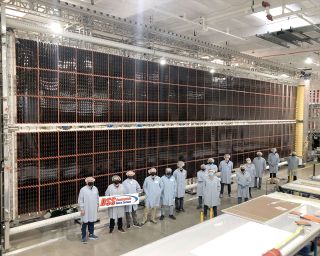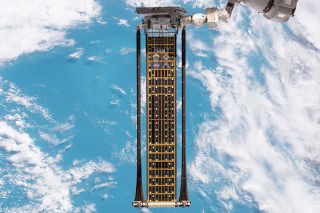Boeing to boost space station power supply with new solar arrays

The International Space Station (ISS) will soon be getting a power-up.
The space station, which has drawn the majority of its electricity from eight large solar panels for the past 15 years, will be augmented with six new solar arrays beginning later this year. The new addition will provide a 20 to 30 percent increase in power, enabling the complex's growing research capabilities and commercial opportunities.
"These arrays ... will ensure that ISS remains an incubator and business model in the commercial space ecosystem for the coming decades," John Mulholland, ISS vice president and program manager for Boeing, said in a statement. Boeing will provide the new panels under a $103 million modification to its International Space Station sustainment contract with NASA.
Related: The International Space Station: inside and out (infographic)
The station's original set of solar arrays wings have been continuously operating since they were deployed by space shuttle crews in December 2000, September 2006, June 2007 and March 2009. The first pair of solar arrays has now provided power for more than two decades — five years more than they were designed to support — as more modules were added, the space station's crew grew in number and activities aboard the orbiting laboratory increased.
The current arrays, though they continue to function well, are showing signs of degradation. The new arrays, which will be positioned in front of six of the current panels, are smaller than the existing solar arrays but are more capable, resulting in an overall increase in performance.
"The XTJ Prime space solar cells are much more efficient than any of their predecessors," said Tony Mueller, president of Spectrolab, the Boeing subsidiary that produced both the original and new solar cells for the station. The XTJ Prime solar cells are also the same that will power Boeing's Starliner spacecraft in flight and while docked to the ISS.
Get the Space.com Newsletter
Breaking space news, the latest updates on rocket launches, skywatching events and more!

The new 63-foot-by-20-foot (19-meter-by-6-meter) arrays will shade slightly over half of the length of the existing arrays and will be connected to the same power system to augment the existing supply.
The eight current arrays are currently capable of generating up to 160 kilowatts of power during orbital daytime, about half of which is stored in batteries for use while the station is in Earth's shadow. Each new array will produce more than 20 kilowatts of electricity, totaling 120 kilowatts (120,000 watts) of augmented power during orbital daytime.
The remaining uncovered area of the original solar arrays will continue to generate approximately 95 kilowatts of power for a combined total of up to 215 kilowatts (215,000 watts) of electricity available to support station operations at completion.
The solar arrays will be delivered to the station in pairs in the unpressurized trunks of SpaceX Dragon cargo spacecraft during three resupply missions beginning as soon as May 2021, several months before the second pair of original arrays reach their 15th year of use on orbit. The installation of each new solar array will require two spacewalks: one to prepare the worksite with a modification kit and another to install the panel.

Deployable Space Systems of Santa Barbara, California, is producing the new solar arrays' structure, including the canister and frame that will unfurl to hold the solar array blankets in place.
Deployable Space Systems also built the canister, frame and solar array blanket for a prototype of the XTJ Prime arrays that was successfully tested three and a half years ago aboard the ISS. The Roll-Out Solar Array (ROSA) experiment demonstrated the mechanical capabilities for the arrays' deployment in June 2017.
The new and original arrays together will provide the needed electricity for NASA to use the space station as a springboard for its Artemis missions to the moon, while opening the space station for business and commercial activities, including private astronauts missions.
"Access to this unique lab will continue to pay off as researchers study the challenges of future deep space exploration and make discoveries that improve life on Earth," said Mulholland. "When it comes to game-changing research and technological development, the space station is currently hitting its full stride."
Follow collectSPACE.com on Facebook and on Twitter at @collectSPACE. Copyright 2021 collectSPACE.com. All rights reserved.
Join our Space Forums to keep talking space on the latest missions, night sky and more! And if you have a news tip, correction or comment, let us know at: community@space.com.

Robert Pearlman is a space historian, journalist and the founder and editor of collectSPACE.com, a daily news publication and community devoted to space history with a particular focus on how and where space exploration intersects with pop culture. Pearlman is also a contributing writer for Space.com and co-author of "Space Stations: The Art, Science, and Reality of Working in Space” published by Smithsonian Books in 2018.In 2009, he was inducted into the U.S. Space Camp Hall of Fame in Huntsville, Alabama. In 2021, he was honored by the American Astronautical Society with the Ordway Award for Sustained Excellence in Spaceflight History. In 2023, the National Space Club Florida Committee recognized Pearlman with the Kolcum News and Communications Award for excellence in telling the space story along the Space Coast and throughout the world.











